IT Governance and Strategy: Queensland Health Case Study Report
VerifiedAdded on 2021/05/30
|10
|2029
|228
Report
AI Summary
This report analyzes the Queensland Health payroll system failure, a significant IT project failure in the southern hemisphere. It identifies critical success factors such as communication issues, lack of requirements, and inadequate system testing. The report also details implementation sins, including lack of a proper ERP system and unrealistic stakeholder expectations. Using the COBIT governance framework, the report evaluates the project's scope and testing phases, highlighting the importance of stakeholder involvement and effective monitoring. The analysis emphasizes the significance of communication, governance, and proper planning in project management, offering insights to prevent similar failures. The report concludes by reinforcing the importance of a fixed goal and communication between different sections of the plan for project success.

Running head: IT GOVERNANCE AND STRATEGY
IT GOVERNANCE AND STRATEGY
Name of the Student
Name of the University
Author Note
IT GOVERNANCE AND STRATEGY
Name of the Student
Name of the University
Author Note
Paraphrase This Document
Need a fresh take? Get an instant paraphrase of this document with our AI Paraphraser

2IT GOVERNANCE AND STRATEGY
Table of Contents
Introduction................................................................................................................................3
Task 1.........................................................................................................................................3
Task 2.........................................................................................................................................4
Task 3.........................................................................................................................................4
Task 4.........................................................................................................................................5
Conclusion..................................................................................................................................6
References..................................................................................................................................7
Table of Contents
Introduction................................................................................................................................3
Task 1.........................................................................................................................................3
Task 2.........................................................................................................................................4
Task 3.........................................................................................................................................4
Task 4.........................................................................................................................................5
Conclusion..................................................................................................................................6
References..................................................................................................................................7
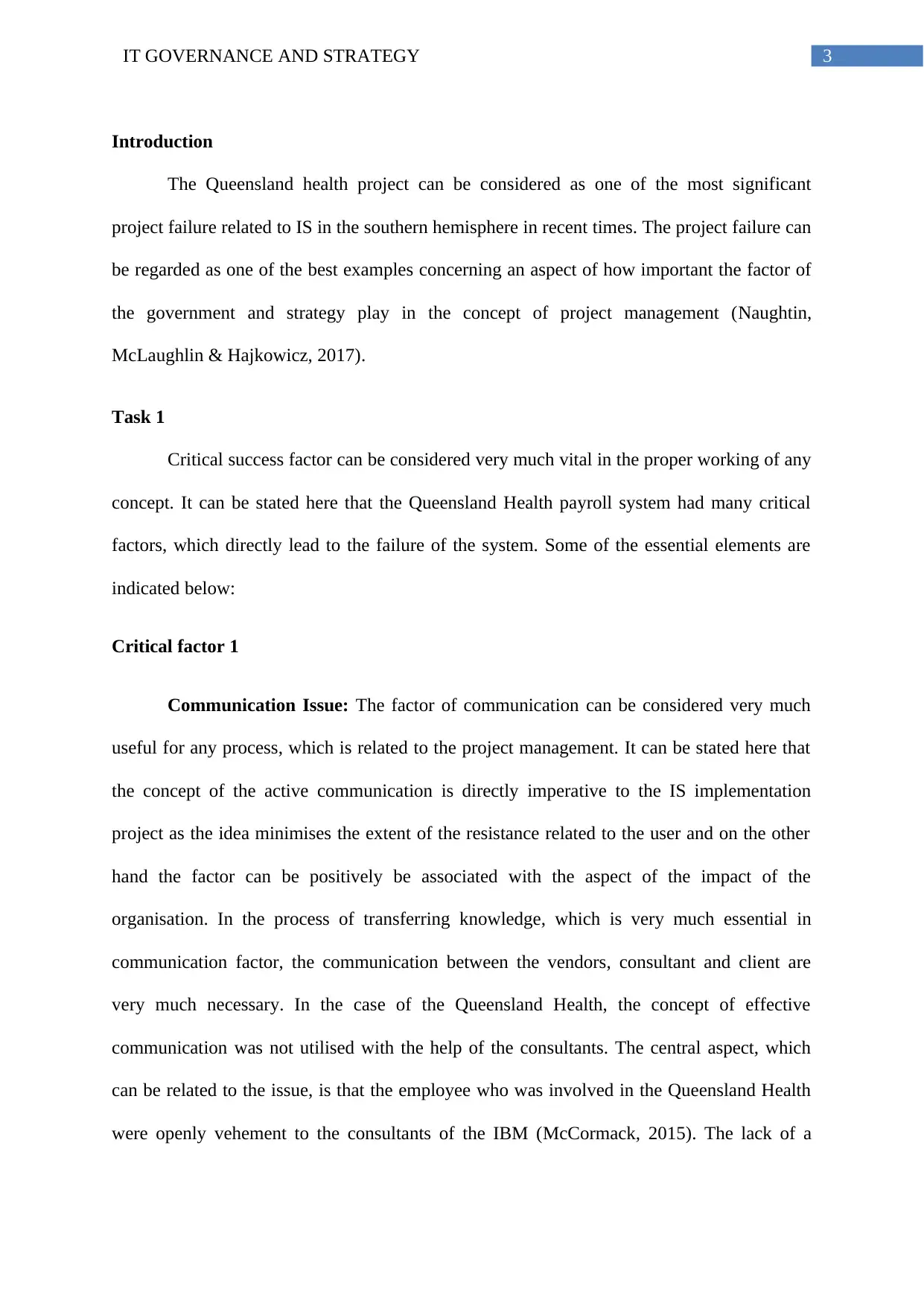
3IT GOVERNANCE AND STRATEGY
Introduction
The Queensland health project can be considered as one of the most significant
project failure related to IS in the southern hemisphere in recent times. The project failure can
be regarded as one of the best examples concerning an aspect of how important the factor of
the government and strategy play in the concept of project management (Naughtin,
McLaughlin & Hajkowicz, 2017).
Task 1
Critical success factor can be considered very much vital in the proper working of any
concept. It can be stated here that the Queensland Health payroll system had many critical
factors, which directly lead to the failure of the system. Some of the essential elements are
indicated below:
Critical factor 1
Communication Issue: The factor of communication can be considered very much
useful for any process, which is related to the project management. It can be stated here that
the concept of the active communication is directly imperative to the IS implementation
project as the idea minimises the extent of the resistance related to the user and on the other
hand the factor can be positively be associated with the aspect of the impact of the
organisation. In the process of transferring knowledge, which is very much essential in
communication factor, the communication between the vendors, consultant and client are
very much necessary. In the case of the Queensland Health, the concept of effective
communication was not utilised with the help of the consultants. The central aspect, which
can be related to the issue, is that the employee who was involved in the Queensland Health
were openly vehement to the consultants of the IBM (McCormack, 2015). The lack of a
Introduction
The Queensland health project can be considered as one of the most significant
project failure related to IS in the southern hemisphere in recent times. The project failure can
be regarded as one of the best examples concerning an aspect of how important the factor of
the government and strategy play in the concept of project management (Naughtin,
McLaughlin & Hajkowicz, 2017).
Task 1
Critical success factor can be considered very much vital in the proper working of any
concept. It can be stated here that the Queensland Health payroll system had many critical
factors, which directly lead to the failure of the system. Some of the essential elements are
indicated below:
Critical factor 1
Communication Issue: The factor of communication can be considered very much
useful for any process, which is related to the project management. It can be stated here that
the concept of the active communication is directly imperative to the IS implementation
project as the idea minimises the extent of the resistance related to the user and on the other
hand the factor can be positively be associated with the aspect of the impact of the
organisation. In the process of transferring knowledge, which is very much essential in
communication factor, the communication between the vendors, consultant and client are
very much necessary. In the case of the Queensland Health, the concept of effective
communication was not utilised with the help of the consultants. The central aspect, which
can be related to the issue, is that the employee who was involved in the Queensland Health
were openly vehement to the consultants of the IBM (McCormack, 2015). The lack of a
⊘ This is a preview!⊘
Do you want full access?
Subscribe today to unlock all pages.

Trusted by 1+ million students worldwide
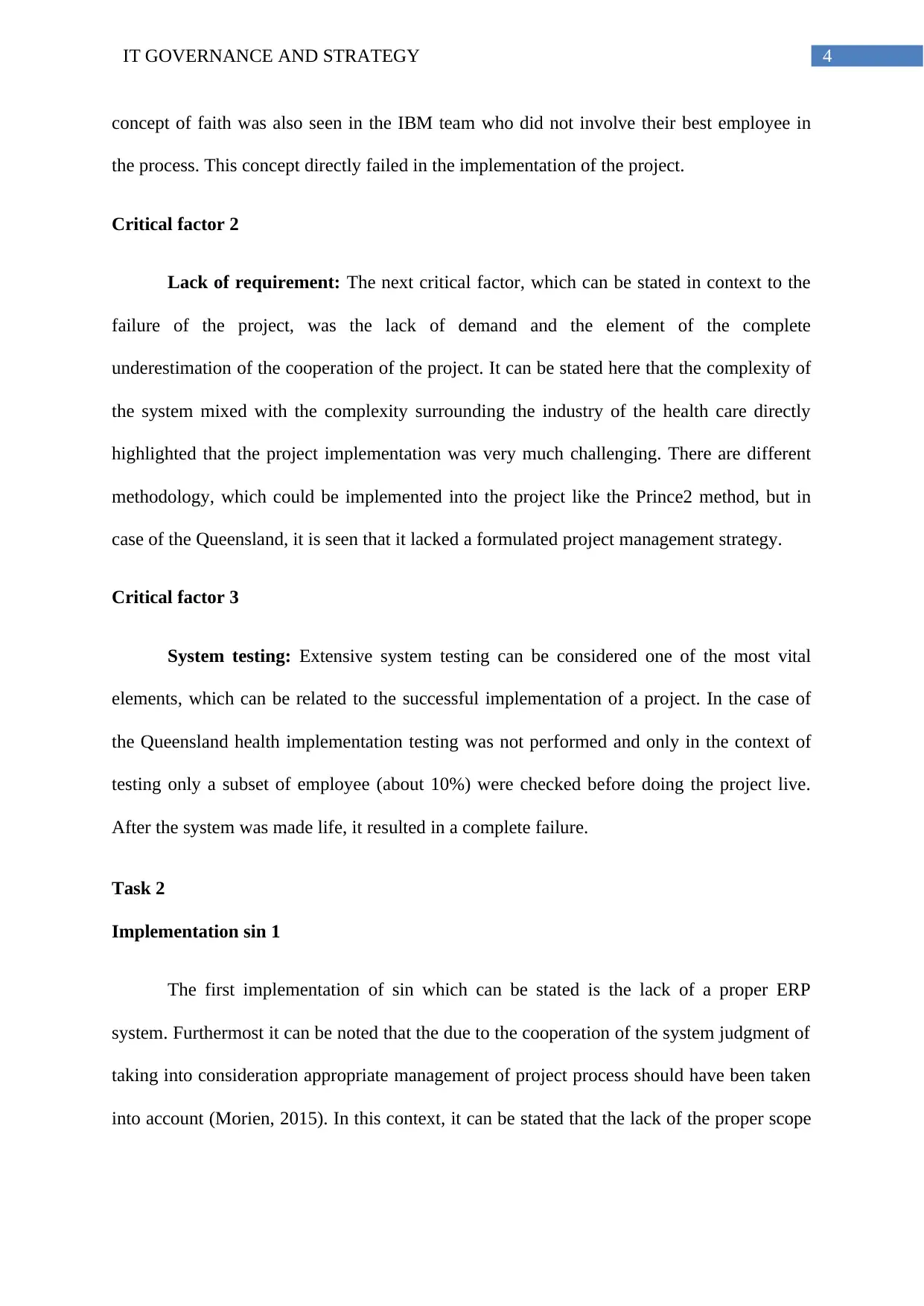
4IT GOVERNANCE AND STRATEGY
concept of faith was also seen in the IBM team who did not involve their best employee in
the process. This concept directly failed in the implementation of the project.
Critical factor 2
Lack of requirement: The next critical factor, which can be stated in context to the
failure of the project, was the lack of demand and the element of the complete
underestimation of the cooperation of the project. It can be stated here that the complexity of
the system mixed with the complexity surrounding the industry of the health care directly
highlighted that the project implementation was very much challenging. There are different
methodology, which could be implemented into the project like the Prince2 method, but in
case of the Queensland, it is seen that it lacked a formulated project management strategy.
Critical factor 3
System testing: Extensive system testing can be considered one of the most vital
elements, which can be related to the successful implementation of a project. In the case of
the Queensland health implementation testing was not performed and only in the context of
testing only a subset of employee (about 10%) were checked before doing the project live.
After the system was made life, it resulted in a complete failure.
Task 2
Implementation sin 1
The first implementation of sin which can be stated is the lack of a proper ERP
system. Furthermost it can be noted that the due to the cooperation of the system judgment of
taking into consideration appropriate management of project process should have been taken
into account (Morien, 2015). In this context, it can be stated that the lack of the proper scope
concept of faith was also seen in the IBM team who did not involve their best employee in
the process. This concept directly failed in the implementation of the project.
Critical factor 2
Lack of requirement: The next critical factor, which can be stated in context to the
failure of the project, was the lack of demand and the element of the complete
underestimation of the cooperation of the project. It can be stated here that the complexity of
the system mixed with the complexity surrounding the industry of the health care directly
highlighted that the project implementation was very much challenging. There are different
methodology, which could be implemented into the project like the Prince2 method, but in
case of the Queensland, it is seen that it lacked a formulated project management strategy.
Critical factor 3
System testing: Extensive system testing can be considered one of the most vital
elements, which can be related to the successful implementation of a project. In the case of
the Queensland health implementation testing was not performed and only in the context of
testing only a subset of employee (about 10%) were checked before doing the project live.
After the system was made life, it resulted in a complete failure.
Task 2
Implementation sin 1
The first implementation of sin which can be stated is the lack of a proper ERP
system. Furthermost it can be noted that the due to the cooperation of the system judgment of
taking into consideration appropriate management of project process should have been taken
into account (Morien, 2015). In this context, it can be stated that the lack of the proper scope
Paraphrase This Document
Need a fresh take? Get an instant paraphrase of this document with our AI Paraphraser
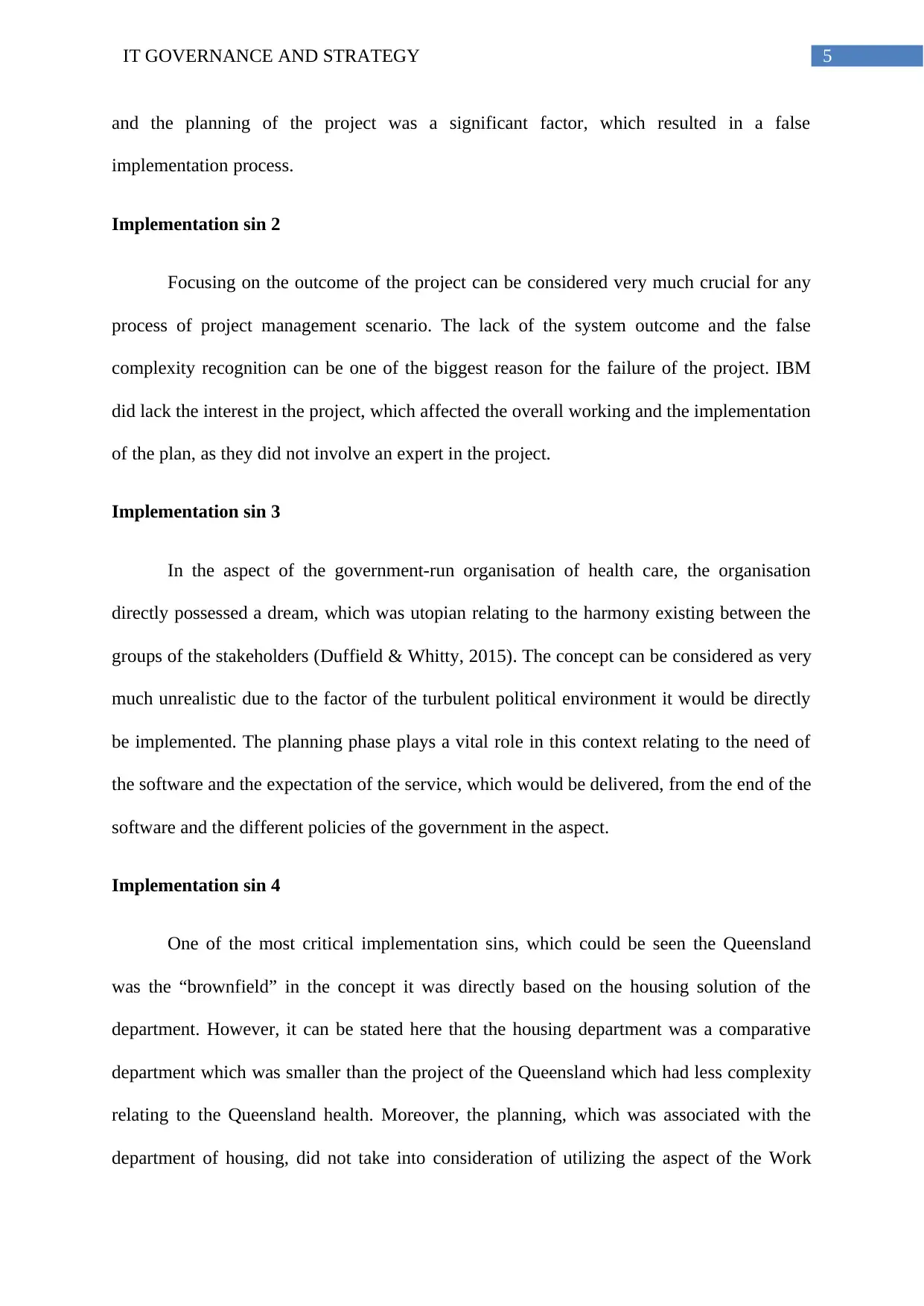
5IT GOVERNANCE AND STRATEGY
and the planning of the project was a significant factor, which resulted in a false
implementation process.
Implementation sin 2
Focusing on the outcome of the project can be considered very much crucial for any
process of project management scenario. The lack of the system outcome and the false
complexity recognition can be one of the biggest reason for the failure of the project. IBM
did lack the interest in the project, which affected the overall working and the implementation
of the plan, as they did not involve an expert in the project.
Implementation sin 3
In the aspect of the government-run organisation of health care, the organisation
directly possessed a dream, which was utopian relating to the harmony existing between the
groups of the stakeholders (Duffield & Whitty, 2015). The concept can be considered as very
much unrealistic due to the factor of the turbulent political environment it would be directly
be implemented. The planning phase plays a vital role in this context relating to the need of
the software and the expectation of the service, which would be delivered, from the end of the
software and the different policies of the government in the aspect.
Implementation sin 4
One of the most critical implementation sins, which could be seen the Queensland
was the “brownfield” in the concept it was directly based on the housing solution of the
department. However, it can be stated here that the housing department was a comparative
department which was smaller than the project of the Queensland which had less complexity
relating to the Queensland health. Moreover, the planning, which was associated with the
department of housing, did not take into consideration of utilizing the aspect of the Work
and the planning of the project was a significant factor, which resulted in a false
implementation process.
Implementation sin 2
Focusing on the outcome of the project can be considered very much crucial for any
process of project management scenario. The lack of the system outcome and the false
complexity recognition can be one of the biggest reason for the failure of the project. IBM
did lack the interest in the project, which affected the overall working and the implementation
of the plan, as they did not involve an expert in the project.
Implementation sin 3
In the aspect of the government-run organisation of health care, the organisation
directly possessed a dream, which was utopian relating to the harmony existing between the
groups of the stakeholders (Duffield & Whitty, 2015). The concept can be considered as very
much unrealistic due to the factor of the turbulent political environment it would be directly
be implemented. The planning phase plays a vital role in this context relating to the need of
the software and the expectation of the service, which would be delivered, from the end of the
software and the different policies of the government in the aspect.
Implementation sin 4
One of the most critical implementation sins, which could be seen the Queensland
was the “brownfield” in the concept it was directly based on the housing solution of the
department. However, it can be stated here that the housing department was a comparative
department which was smaller than the project of the Queensland which had less complexity
relating to the Queensland health. Moreover, the planning, which was associated with the
department of housing, did not take into consideration of utilizing the aspect of the Work
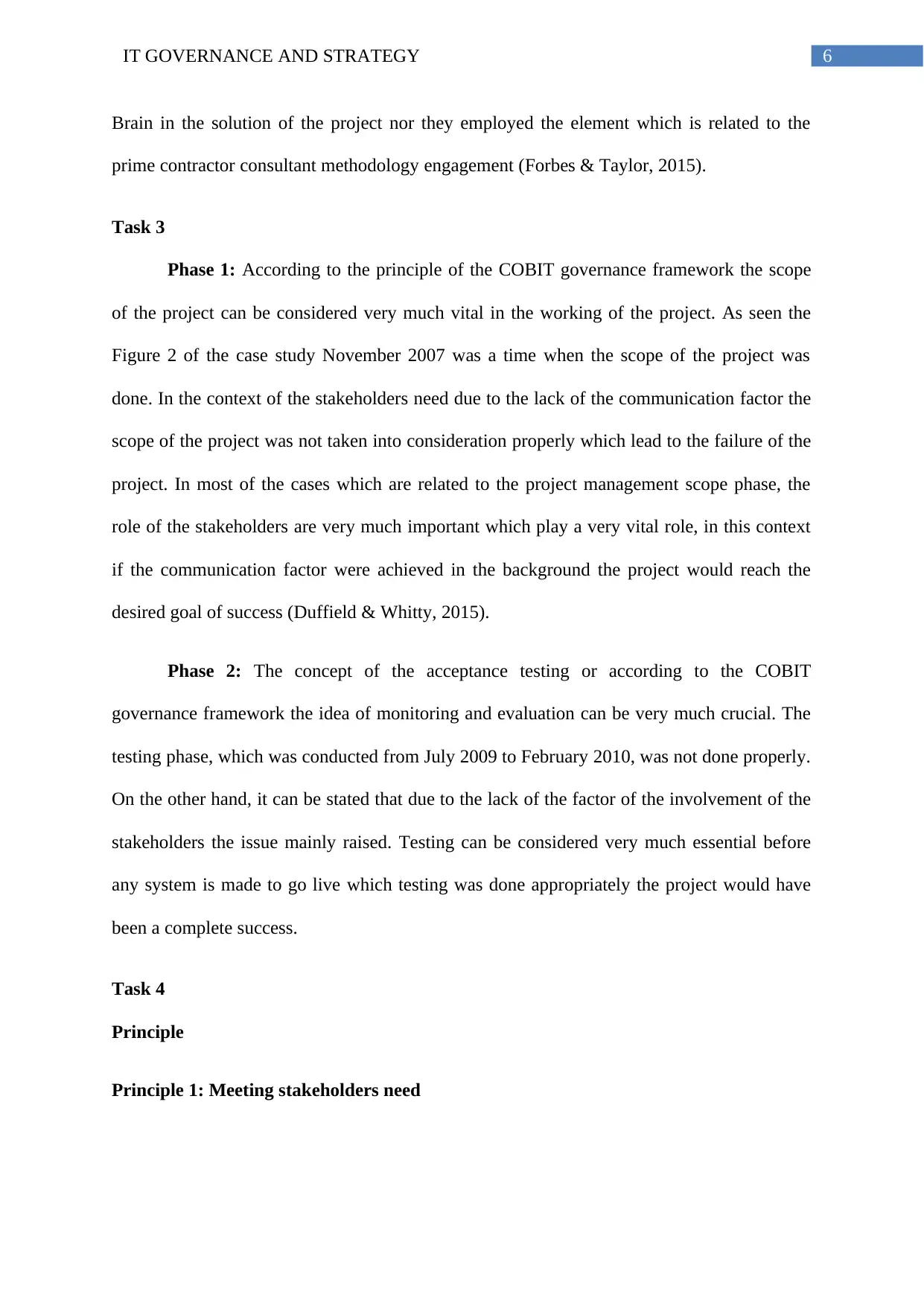
6IT GOVERNANCE AND STRATEGY
Brain in the solution of the project nor they employed the element which is related to the
prime contractor consultant methodology engagement (Forbes & Taylor, 2015).
Task 3
Phase 1: According to the principle of the COBIT governance framework the scope
of the project can be considered very much vital in the working of the project. As seen the
Figure 2 of the case study November 2007 was a time when the scope of the project was
done. In the context of the stakeholders need due to the lack of the communication factor the
scope of the project was not taken into consideration properly which lead to the failure of the
project. In most of the cases which are related to the project management scope phase, the
role of the stakeholders are very much important which play a very vital role, in this context
if the communication factor were achieved in the background the project would reach the
desired goal of success (Duffield & Whitty, 2015).
Phase 2: The concept of the acceptance testing or according to the COBIT
governance framework the idea of monitoring and evaluation can be very much crucial. The
testing phase, which was conducted from July 2009 to February 2010, was not done properly.
On the other hand, it can be stated that due to the lack of the factor of the involvement of the
stakeholders the issue mainly raised. Testing can be considered very much essential before
any system is made to go live which testing was done appropriately the project would have
been a complete success.
Task 4
Principle
Principle 1: Meeting stakeholders need
Brain in the solution of the project nor they employed the element which is related to the
prime contractor consultant methodology engagement (Forbes & Taylor, 2015).
Task 3
Phase 1: According to the principle of the COBIT governance framework the scope
of the project can be considered very much vital in the working of the project. As seen the
Figure 2 of the case study November 2007 was a time when the scope of the project was
done. In the context of the stakeholders need due to the lack of the communication factor the
scope of the project was not taken into consideration properly which lead to the failure of the
project. In most of the cases which are related to the project management scope phase, the
role of the stakeholders are very much important which play a very vital role, in this context
if the communication factor were achieved in the background the project would reach the
desired goal of success (Duffield & Whitty, 2015).
Phase 2: The concept of the acceptance testing or according to the COBIT
governance framework the idea of monitoring and evaluation can be very much crucial. The
testing phase, which was conducted from July 2009 to February 2010, was not done properly.
On the other hand, it can be stated that due to the lack of the factor of the involvement of the
stakeholders the issue mainly raised. Testing can be considered very much essential before
any system is made to go live which testing was done appropriately the project would have
been a complete success.
Task 4
Principle
Principle 1: Meeting stakeholders need
⊘ This is a preview!⊘
Do you want full access?
Subscribe today to unlock all pages.

Trusted by 1+ million students worldwide
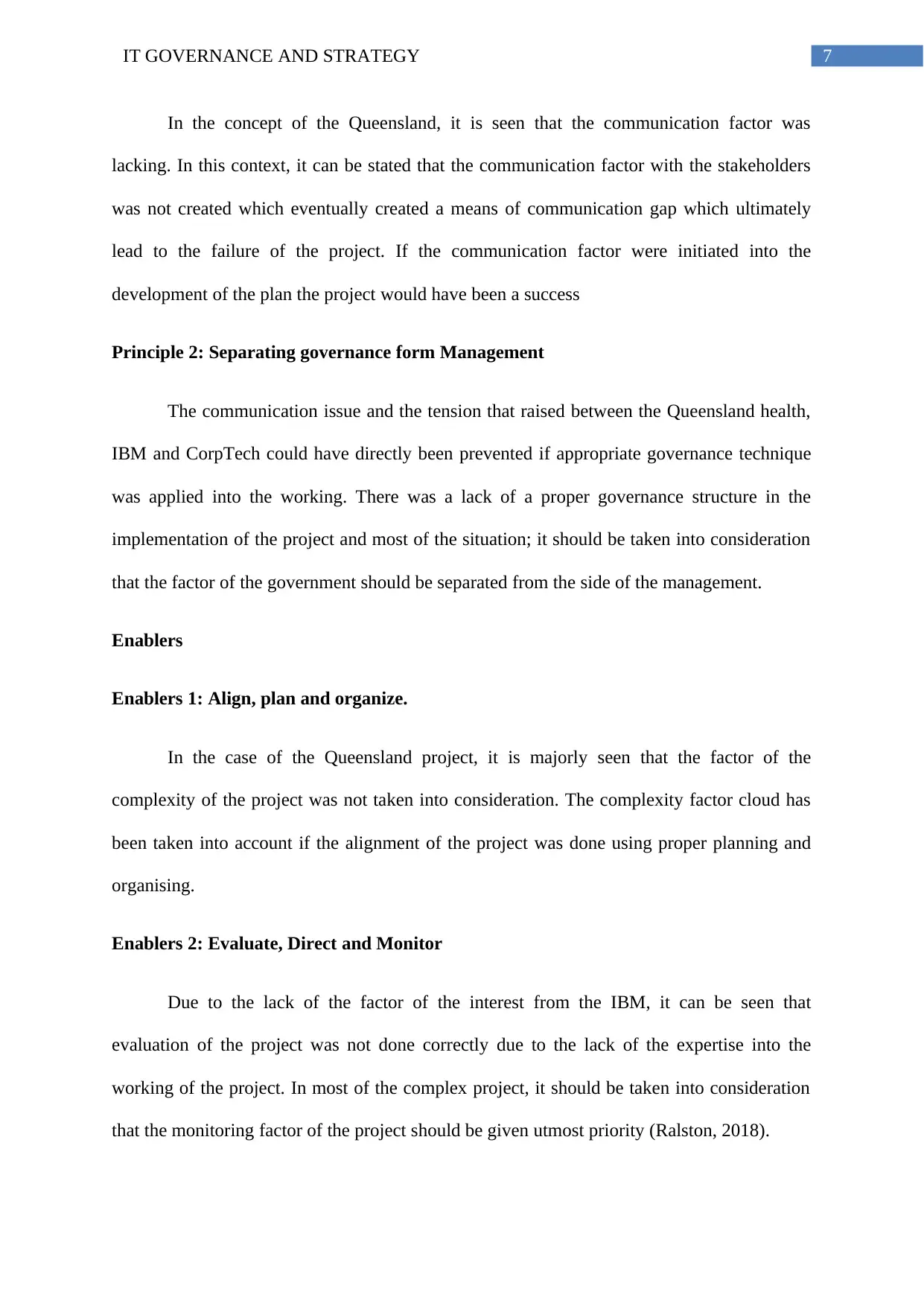
7IT GOVERNANCE AND STRATEGY
In the concept of the Queensland, it is seen that the communication factor was
lacking. In this context, it can be stated that the communication factor with the stakeholders
was not created which eventually created a means of communication gap which ultimately
lead to the failure of the project. If the communication factor were initiated into the
development of the plan the project would have been a success
Principle 2: Separating governance form Management
The communication issue and the tension that raised between the Queensland health,
IBM and CorpTech could have directly been prevented if appropriate governance technique
was applied into the working. There was a lack of a proper governance structure in the
implementation of the project and most of the situation; it should be taken into consideration
that the factor of the government should be separated from the side of the management.
Enablers
Enablers 1: Align, plan and organize.
In the case of the Queensland project, it is majorly seen that the factor of the
complexity of the project was not taken into consideration. The complexity factor cloud has
been taken into account if the alignment of the project was done using proper planning and
organising.
Enablers 2: Evaluate, Direct and Monitor
Due to the lack of the factor of the interest from the IBM, it can be seen that
evaluation of the project was not done correctly due to the lack of the expertise into the
working of the project. In most of the complex project, it should be taken into consideration
that the monitoring factor of the project should be given utmost priority (Ralston, 2018).
In the concept of the Queensland, it is seen that the communication factor was
lacking. In this context, it can be stated that the communication factor with the stakeholders
was not created which eventually created a means of communication gap which ultimately
lead to the failure of the project. If the communication factor were initiated into the
development of the plan the project would have been a success
Principle 2: Separating governance form Management
The communication issue and the tension that raised between the Queensland health,
IBM and CorpTech could have directly been prevented if appropriate governance technique
was applied into the working. There was a lack of a proper governance structure in the
implementation of the project and most of the situation; it should be taken into consideration
that the factor of the government should be separated from the side of the management.
Enablers
Enablers 1: Align, plan and organize.
In the case of the Queensland project, it is majorly seen that the factor of the
complexity of the project was not taken into consideration. The complexity factor cloud has
been taken into account if the alignment of the project was done using proper planning and
organising.
Enablers 2: Evaluate, Direct and Monitor
Due to the lack of the factor of the interest from the IBM, it can be seen that
evaluation of the project was not done correctly due to the lack of the expertise into the
working of the project. In most of the complex project, it should be taken into consideration
that the monitoring factor of the project should be given utmost priority (Ralston, 2018).
Paraphrase This Document
Need a fresh take? Get an instant paraphrase of this document with our AI Paraphraser
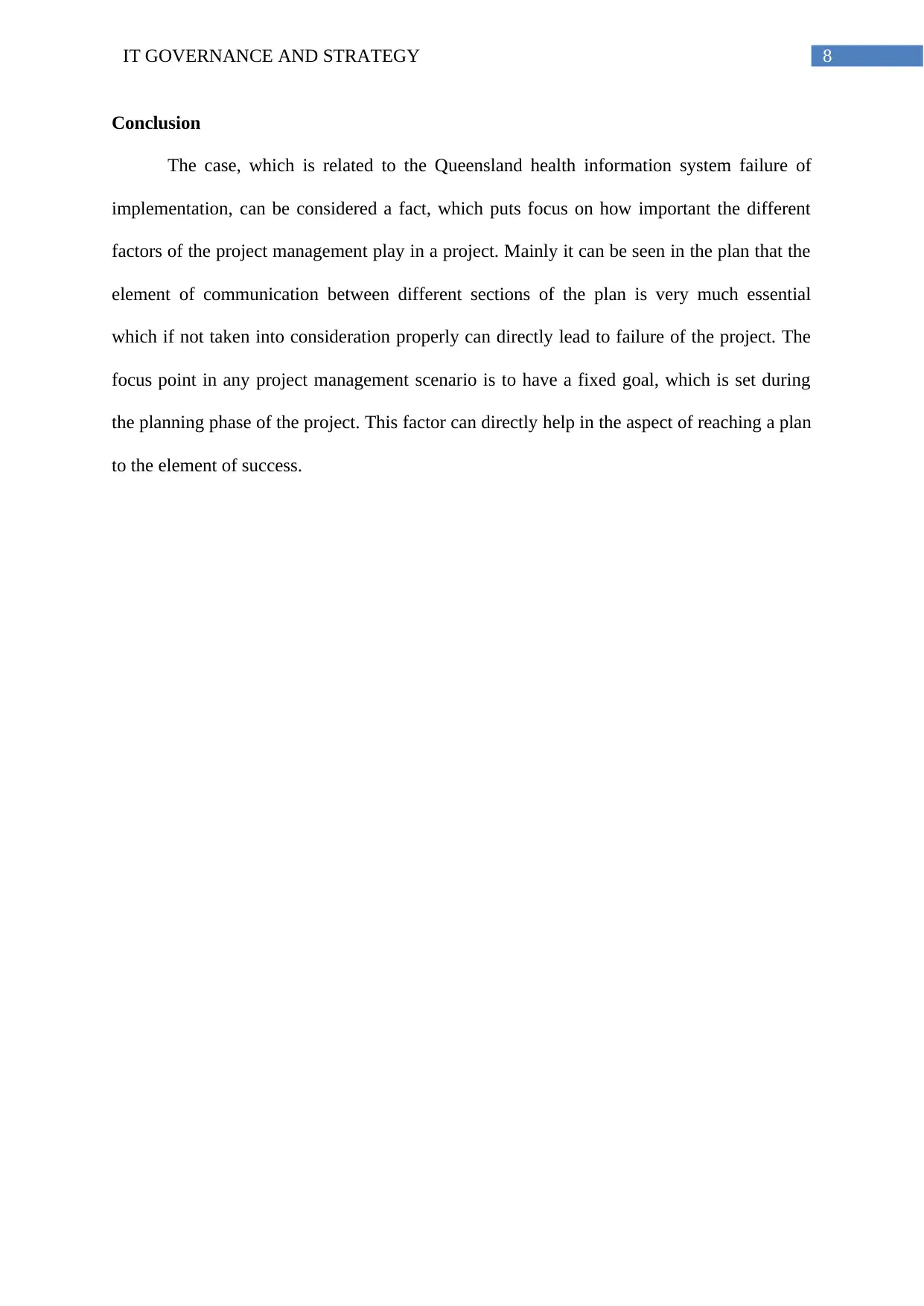
8IT GOVERNANCE AND STRATEGY
Conclusion
The case, which is related to the Queensland health information system failure of
implementation, can be considered a fact, which puts focus on how important the different
factors of the project management play in a project. Mainly it can be seen in the plan that the
element of communication between different sections of the plan is very much essential
which if not taken into consideration properly can directly lead to failure of the project. The
focus point in any project management scenario is to have a fixed goal, which is set during
the planning phase of the project. This factor can directly help in the aspect of reaching a plan
to the element of success.
Conclusion
The case, which is related to the Queensland health information system failure of
implementation, can be considered a fact, which puts focus on how important the different
factors of the project management play in a project. Mainly it can be seen in the plan that the
element of communication between different sections of the plan is very much essential
which if not taken into consideration properly can directly lead to failure of the project. The
focus point in any project management scenario is to have a fixed goal, which is set during
the planning phase of the project. This factor can directly help in the aspect of reaching a plan
to the element of success.
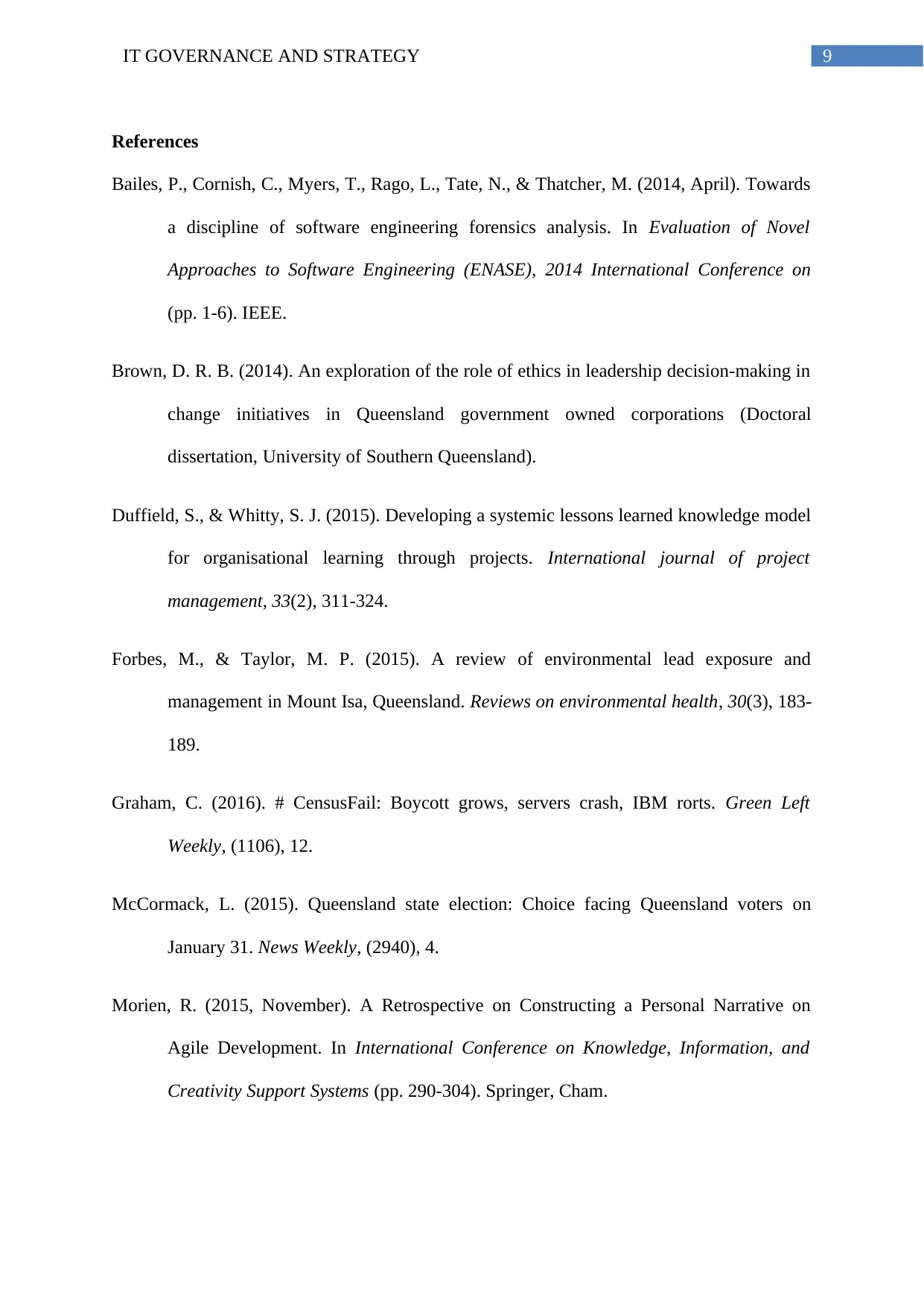
9IT GOVERNANCE AND STRATEGY
References
Bailes, P., Cornish, C., Myers, T., Rago, L., Tate, N., & Thatcher, M. (2014, April). Towards
a discipline of software engineering forensics analysis. In Evaluation of Novel
Approaches to Software Engineering (ENASE), 2014 International Conference on
(pp. 1-6). IEEE.
Brown, D. R. B. (2014). An exploration of the role of ethics in leadership decision-making in
change initiatives in Queensland government owned corporations (Doctoral
dissertation, University of Southern Queensland).
Duffield, S., & Whitty, S. J. (2015). Developing a systemic lessons learned knowledge model
for organisational learning through projects. International journal of project
management, 33(2), 311-324.
Forbes, M., & Taylor, M. P. (2015). A review of environmental lead exposure and
management in Mount Isa, Queensland. Reviews on environmental health, 30(3), 183-
189.
Graham, C. (2016). # CensusFail: Boycott grows, servers crash, IBM rorts. Green Left
Weekly, (1106), 12.
McCormack, L. (2015). Queensland state election: Choice facing Queensland voters on
January 31. News Weekly, (2940), 4.
Morien, R. (2015, November). A Retrospective on Constructing a Personal Narrative on
Agile Development. In International Conference on Knowledge, Information, and
Creativity Support Systems (pp. 290-304). Springer, Cham.
References
Bailes, P., Cornish, C., Myers, T., Rago, L., Tate, N., & Thatcher, M. (2014, April). Towards
a discipline of software engineering forensics analysis. In Evaluation of Novel
Approaches to Software Engineering (ENASE), 2014 International Conference on
(pp. 1-6). IEEE.
Brown, D. R. B. (2014). An exploration of the role of ethics in leadership decision-making in
change initiatives in Queensland government owned corporations (Doctoral
dissertation, University of Southern Queensland).
Duffield, S., & Whitty, S. J. (2015). Developing a systemic lessons learned knowledge model
for organisational learning through projects. International journal of project
management, 33(2), 311-324.
Forbes, M., & Taylor, M. P. (2015). A review of environmental lead exposure and
management in Mount Isa, Queensland. Reviews on environmental health, 30(3), 183-
189.
Graham, C. (2016). # CensusFail: Boycott grows, servers crash, IBM rorts. Green Left
Weekly, (1106), 12.
McCormack, L. (2015). Queensland state election: Choice facing Queensland voters on
January 31. News Weekly, (2940), 4.
Morien, R. (2015, November). A Retrospective on Constructing a Personal Narrative on
Agile Development. In International Conference on Knowledge, Information, and
Creativity Support Systems (pp. 290-304). Springer, Cham.
⊘ This is a preview!⊘
Do you want full access?
Subscribe today to unlock all pages.

Trusted by 1+ million students worldwide

10IT GOVERNANCE AND STRATEGY
Naughtin, C., McLaughlin, J., & Hajkowicz, S. (2017). Opportunities for growth: Driving
forces creating economic opportunities for Queensland companies over the coming
decade.
Ralston, B. (2018). Does payroll tax affect firm behaviour?.
Williams, L. (2016). NDIS: No quality or secure guidelines. Green Left Weekly, (1106), 12.
Naughtin, C., McLaughlin, J., & Hajkowicz, S. (2017). Opportunities for growth: Driving
forces creating economic opportunities for Queensland companies over the coming
decade.
Ralston, B. (2018). Does payroll tax affect firm behaviour?.
Williams, L. (2016). NDIS: No quality or secure guidelines. Green Left Weekly, (1106), 12.
1 out of 10
Related Documents
Your All-in-One AI-Powered Toolkit for Academic Success.
+13062052269
info@desklib.com
Available 24*7 on WhatsApp / Email
![[object Object]](/_next/static/media/star-bottom.7253800d.svg)
Unlock your academic potential
Copyright © 2020–2025 A2Z Services. All Rights Reserved. Developed and managed by ZUCOL.





